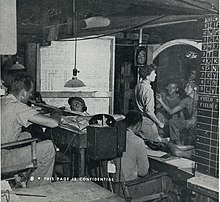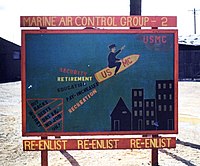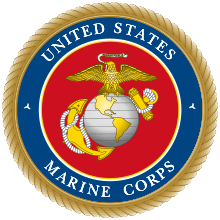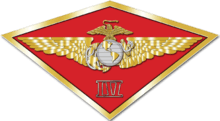Marine Aircraft Group 43
Marine Aircraft Group 43 (MAG-43) was a fixed wing aviation group in the United States Marine Corps Reserve based at Naval Air Station Joint Reserve Base Willow Grove, Pennsylvania.
| Marine Aircraft Group 43 | |
|---|---|
| Active | Jan 1, 1943 - Jul 28, 1955 Jul 1, 1962 - Sep 1, 1972 |
| Country | United States |
| Allegiance | |
| Branch | |
| Type | Reserve aircraft group |
| Part of | 4th Marine Aircraft Wing Marine Forces Reserve |
| Garrison/HQ | Naval Air Station Joint Reserve Base Willow Grove |
| Engagements | World War II * Battle of Okinawa Korean War |
| Commanders | |
| Current commander | N/A |
| Notable commanders | Robert O. Bisson |
The group was originally formed during World War II as the administrative headquarters for all Marine Corps units training at Marine Corps Air Station El Centro, California. A mission change in late 1944 saw MAG-43 tasked to serve as the headquarters for the Air Defense Command of the Tactical Air Force, Tenth Army during the Battle of Okinawa. In this role the group was responsible for the employment of all land based fighters, radars and antiaircraft units. The group was later re-designated as Marine Air Control Group 2 (MACG-2) and saw service during the Korean War again overseeing Marine Corps aviation command and control equities. Deactivated in July 1955, the group was reactivated in 1962 as a part of a restructure of aviation within the Marine Corps Reserve. In 1969 the group was transferred to the 4th Marine Aircraft Wing until its deactivation in September 1972.
History
World War II
Organization
Marine Aircraft Group 23 returned to Hawaii from Guadalcanal on November 19, 1942. The group's personnel were split up into four cadres that were used to form the initial personnel for four additional Marine aircraft groups.[1] One of these four new groups, Marine Aircraft Base Defense Group 43, was activated on January 1, 1943 at Marine Corps Air Station El Centro, California.[2] For its first two years MABDG-43 was the headquarters that oversaw training at MCAS El Centro and also participated in the defense of the west coast.[3] On xx Oct/Nov 1944 the group's group's mission was changed. It was tasked with coordinating and controlling the air defense fight for the upcoming invasion of Okinawa. It was re-designated Marine Aircraft Group 43 (MAG-43) on December 10, 1944.[3]
Okinawa

The group embarked on the USS Carteret (APA-70) at San Diego, California on January 24, 1945. It arrived at Pearl Harbor, Hawaii on 30 January and established itself at Marine Corps Air Station Ewa. For the upcoming Battle of Okinawa, the 2nd Marine Aircraft Wing (2d MAW) was made available to serve as the headquarters for the Tactical Air Force (TAF). The TAF was in command of all land-based aircraft during the battle. MAG-43's role for the battle was to serve as the headquarters for the Tactical Air Force's Air Defense Command (ADC) which had BGen William J. Wallace in command.[4] On February 22 the group embarked on the USS Allendale and sailed west.
Mission at Okinawa[5]
1) Control all fighter aircraft assigned to Tactical Air Force in execution of all assigned defensive and offensive missions.
2) Establish and Air Defense Command and Air Defense Control Center as soon as possible.
3) Assuming control of air defense including anti-aircraft artillery and searchlights from Commander, Air Support Control Units on order.
4) Establish and operate and early warning net.
5) Furnishing direct defense of the area in conjunction with fleet aircraft present.
6) Be prepared from time of initial establishment for emergency assistance to shipborne Air Support Control Units in handling carrier aircraft forced to land ashore.
On April 1, the group arrived off the coast of Okinawa, Japan and finally went ashore April 3. The Group's Expeditionary Air Defense Control Center, callsign Handyman, went on the air on April 7, 1945 based out of three LVTs modified with extra radios.[4] On April 16, MAG-43 established its full Air Defense Control Center (ADCC) in a farmer's house about a half mile southeast of Yontan Airfield in the village of Yomitan. By June 30, MAG-43 consisted of 1,926 Marines with another 505 attached US Army personnel.[6]
On August 1, 1945, MAG-43 was re-designated as Marine Air Defense Command 2 (MADC-2) under the 2nd Marine Aircraft Wing. That same month it moved from its position in Yomitan to higher ground on the eastern side of Okinawa just north of Nakagusuku Castle.
The group arrived in San Diego on board the USS Waukesha (AKA-84) on April 15, 1946 and was assigned to Marine Air West Coast at Marine Corps Air Station Miramar, California. On August 1, 1946 the group was again re-designated this time as Marine Air Control Group 2 (MACG-2). On September 19, 1946, MACG-2 relocated to Marine Corps Air Station El Toro, California. A year later on October 1, 1946 it was placed under the operational control of the 1st Marine Aircraft Wing.
Korean War

At the outbreak of the Korean War, MTACS-2 and MGCIS-1 from MACG-2 were transferred to Marine Aircraft Group 33 to provide air support and air defense capabilities for the 1st Provisional Marine Brigade.[7] Both squadrons were severely under strength and additional Marines were joined from other squadrons within MACG-2 to fill out the ranks prior to deployment.[8] On August 3, Marine Ground Control Intercept Squadron 2 and Marine Tactical Air Control Squadron 3 were commissioned under MACG-2 to replace the transferred units. Manpower for these new squadrons came from the recently activated Marine Corps Reserve.[7]
On March 4, 1951, MACG-2 departed MCAS El Toro for San Francisco, California. The Group departed San Francisco the next day on board the USS General W. F. Hase (AP-146). It arrived at Kobe, Japan and established headquarters at Itami Air Force Base. Between April 11–20 MACG-2 personnel were transported to South Korea via aircraft and naval shipping.[9] MACG-2 established its headquarters at K-3 Air Base outside of Pohang and for the rest of the month was busy constructing its camp, quarters and working spaces.[10] [9]
While in Korea, MACG-2 was responsible for providing, operating and maintaining the 1st Marine Aircraft Wing's (1st MAW) tactical headquarters which was known as the Tactical Air Control Center (TACC). The TACC exercised operational control and direction of Marine Corps aircraft operating in Korea.[11]
In February 1952 the 1st Marine Aircraft Wing's Electronic Countermeasures Section was transferred under MACG-2 which also oversaw the Wing's airborne early warning capability that was provided by MACG-2's radar equipped AD-1 Skyraiders. The Electronic Countermeasures Section was utilized to find and classify North Korean radar sites. This section eventually became Marine Composite Squadron 1 (VMC-1) on September 15, 1952.[12]
MACG-2 departed Korea on May 25, 1955 on board the USS Washburn (AKA-108). The ship arrived at San Pedro, California on June 11 and the group immediately returned to MCAS El Toro. MACG-2 was deactivated at MCAS El Toro on July 28, 1955.
Reserve duty
MAG-43 was reactivated at Naval Air Station Willow Grove, Pennsylvania on July 1, 1962.[15] On February 1, 1965 the Group was transferred underneath the newly reactivated 4th Marine Aircraft Wing. The group was deactivated as part of the post-Vietnam drawdown of forces on September 1, 1972.[16]
Unit awards
A unit citation or commendation is an award bestowed upon an organization for the action cited. Members of the unit who participated in said actions are allowed to wear on their uniforms the awarded unit citation. MAG-43 has been presented with the following awards:
| Streamer | Award | Year(s) | Additional Info |
|---|---|---|---|
| Presidential Unit Citation Streamer with one Bronze Star | 1945, 1951 | Okinawa, Korea | |
| Navy Unit Commendation Streamer | 1952-1953 | Korea | |
| American Campaign Streamer | 1943-45 | World War II | |
| Asiatic-Pacific Campaign Streamer with one Bronze Star | 1945 | Okinawa | |
| World War II Victory Streamer | 1941–1945 | Pacific War | |
| National Defense Service Streamer | 1951–1954, 1961–1974, 1990–1995, 2001–present | Korean War | |
| Korean Service Streamer with one Silver Star and two Bronze Stars | 1950-1953 | First UN Counter-offensive 1951, Communist China Spring Offensive 1951, UN Summer-Fall Offensive 1951, Second Korean Winter 1951-52, Korean Defense Summer-Fall 1952, Third Korean Winter 1952-53, Korea Summer-Fall 1953 |
See also
- List of United States Marine Corps aircraft groups
- List of United States Marine Corps aviation support squadrons
Citations
- Garand, George W.; Strobridge, Truman R. (1971). History of U.S. Marine Corps Operations in World War II Volume IV: Western Pacific Operations. Washington D.C.: Marine Corps Historical Branch. p. 45.
- Wolf 1999, pp. 19.
- Rottman 2002, pp. 436.
- Sherrod 1952, pp. 443.
- Marine Air Defense Command Two War Diary for 1 August to 31 August 1945 (Report). Marine Air Defense Command 2. September 5, 1945.
- Sherrod 1952, pp. 403.
- "Historical Report Marine Air Control Group 2" (PDF). www.koreanwar2.org. United States Marine Corps. 15 January 1951. Retrieved 4 July 2020.
- Hammes 2010, pp. 114–115.
- "Historical Diary - Marine Air Control Group 2 - April 1951" (PDF). www.koreanwar2.org. United States Marine Corps. 15 May 1951. Retrieved 4 July 2020.
- Condon 2002, pp. 37.
- "MACG-2 Command Diary - June 1953" (PDF). www.koreanwar.org. United States Marine Corps. 12 August 1953. Retrieved 25 June 2020.
- "1st Marine Aircraft Wing Headquarters Squadron (HEDRON-1) and MACG-2 AEW/ECM Section History". www.mcara.us. Marine Corps Aviation Reconnaissance Association. Retrieved 25 June 2020.
-
- "Reserve Report". Marine Corps Gazette. 52 (9): 62. 1968.
- "Marine Aircraft Group 49 [MAG-49]". www.globalsecurity.org. Federation of American Scientists. Retrieved 14 July 2020.
- Crowder 2000, pp. 155.
References
- Bibliography
- Condon, John P. (2002). Corsairs to Panthers:U.S. Marine Aviation in Korea (PDF). Washington D.C.: Marine Corps Historical Center.
- Crowder, Michael J. (2000). United States Marine Corps Aviation Squadron Lineage, Insignia & History – Volume One – The Fighter Squadrons. Paducah, KY: Turner Publishing Company. ISBN 1-56311-926-9.
- Hammes, T. X. (2010). Forgotten Warriors: The 1st Provisional Marine Brigade, The Corps Ethos, And The Korean War. Lawrence, KS: University Press of Kansas.
- Rottman, Gordon L. (2002). U.S. Marine Corps World War II Order of Battle – Ground and Air Units in the Pacific War. Westport, Connecticut: Greenwood Press. ISBN 0313319065.
- Sherrod, Robert (1952). History of Marine Corps Aviation in World War II. Washington, D.C.: Combat Forces Press. ISBN 0-89201-048-7. OCLC 1261876.
- Wolf, William (1999). Death Rattlers: Marine Squadron VMF-323 Over Okinawa. Atglen, PA: Schiffer Military History. ISBN 0764309536.

